Free printable 3rd Grade 2D shapes worksheets for math practice
Welcome to this amazing world of teaching 3rd graders about 2D shapes. In this article, we will provide you with everything you need to know about 2D shapes for 3rd grade, including what they are, how to identify them, and how to compare and classify them. However, we encourage you to visit Mathskills4kids.com and find a variety of free printable 3rd Grade 2D shapes worksheets for extra math practice at home and in the classroom.
-
Are you looking for a fun and easy way to help your 3rd graders learn about 2D shapes? Do you want to boost their math skills and confidence with engaging and interactive activities? If you answered yes to these questions, you are in the right place!
Download and use our worksheets right away!
Let’s get started!
Why 2D shapes matter for 3rd Graders
There are so many reasons why 2D shapes matter to 3rd graders. First, they are everywhere in our world. They are the building blocks of many objects, patterns, designs, and art. Learning about 2D shapes helps 3rd graders develop spatial awareness, geometry, measurement, and problem-solving skills.
It also prepares them for more advanced math topics in the future, such as area, perimeter, fractions, and algebra.
An amazing unique thing about these Mathskills4kids’ 3rd Grade 2D shapes worksheets is that they cover various 2D shapes concepts that, by the end of 3rd grade, students will be able to:
- Recognize and name common 2D shapes such as circles, squares, rectangles, triangles, pentagons, hexagons, octagons, etc.
- Describe the properties of 2D shapes such as sides, vertices (corners), angles, parallel and perpendicular lines, symmetry, etc.
- Compare and classify 2D shapes based on their properties and attributes.
- Identify and draw lines of symmetry in 2D shapes.
- Identify congruent (same size and shape) and similar (same shape but different size) 2D shapes.
- Identify and perform transformations such as reflection (flip), rotation (turn), and translation (slide) on 2D shapes.
- Apply 2D shapes knowledge to real-life situations and problems.
-
BROWSE THE WEBSITE
-
DOWNLOAD FREE WORKSHEETS
-
-
3rd GRADE MATH TOPICS
- Number and compapring
- Place value
- Addition
- Subtraction
- Understand multiplication
- Multiplication skill builders
- Multiplication fluency
- Multiplication
- Understand division
- Division skill builders
- Division fluency
- Division practice
- Mixed operation
- Properties
- Equations & variations
- Estimate & rounding
- Logical reasoning
- Patterns
- Money
- Telling time
- Data graph & probability
- Understanding fractions
- Equivalent fractions
- Comparing and ordering fractions
- Operations with fractions
- Unit of measurement
- Two-dimensional shapes
- Triangles and quadrilaterals
- 3D shapes
- Geometric measurement
-
-
Counting sides and vertices in two-dimensional shapes
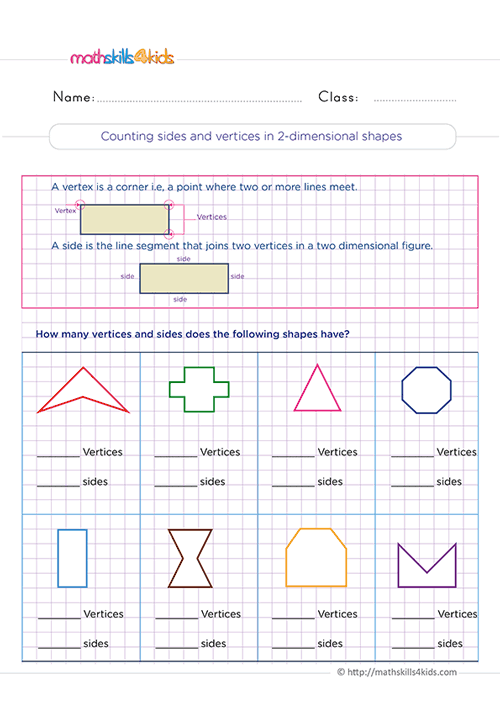 Print it...
Print it...
-
Identifying open and closed shapes practice
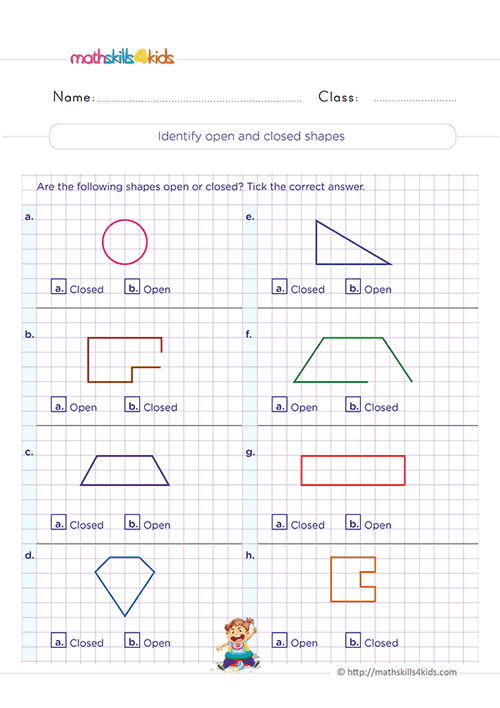 Print it...
Print it...
-
How do you identify a polygon - 2D Shapes practice
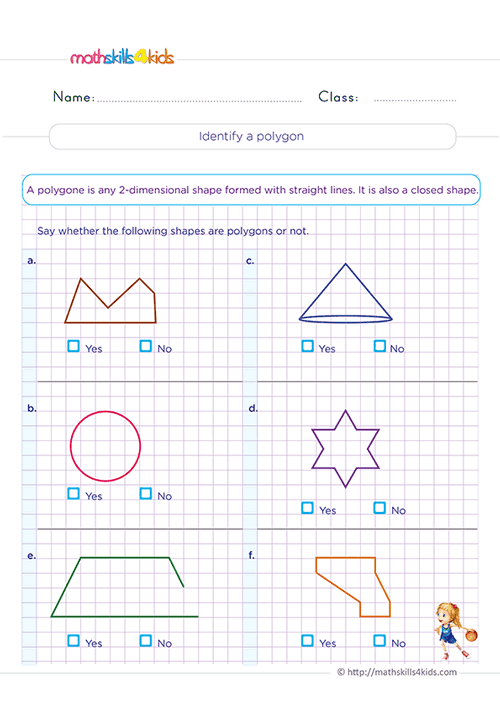 Print it...
Print it...
-
How to identify lines, line segments, and-rays
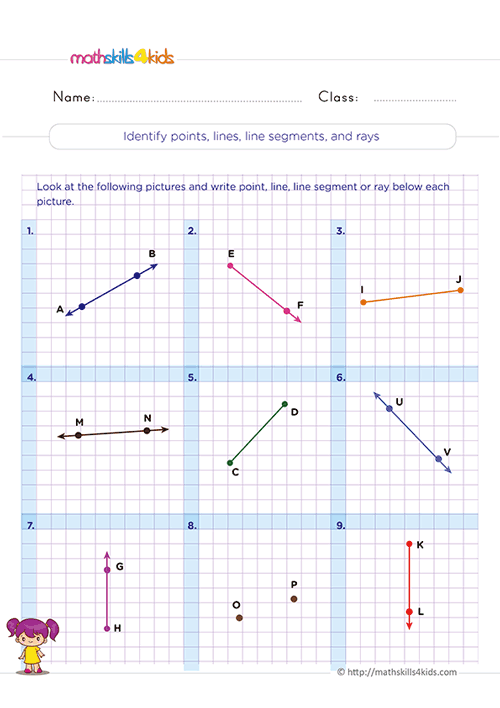 Print it...
Print it...
-
Identifying parallel, perpendicular, and intersecting lines
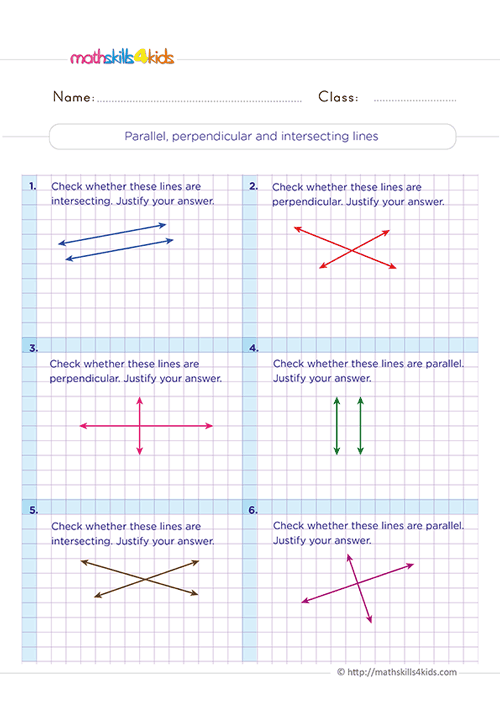 Print it...
Print it...
-
How do you find lines of symmetry on a 2D shape?
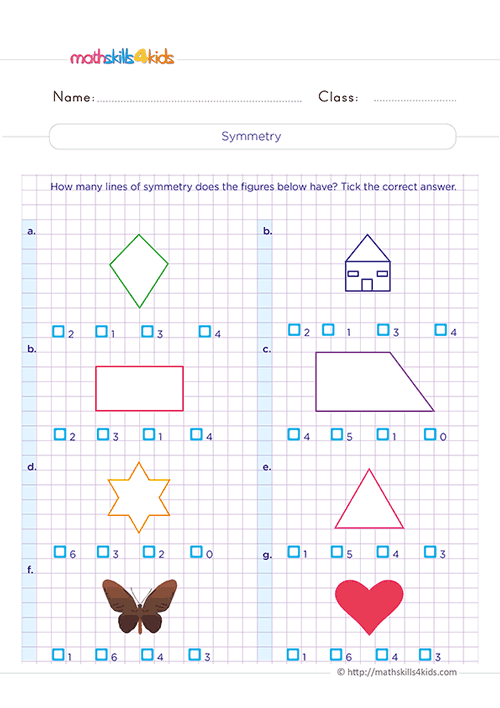 Print it...
Print it...
-
Counting sides and vertices in two-dimensional shapes
-
Buying is supporting us!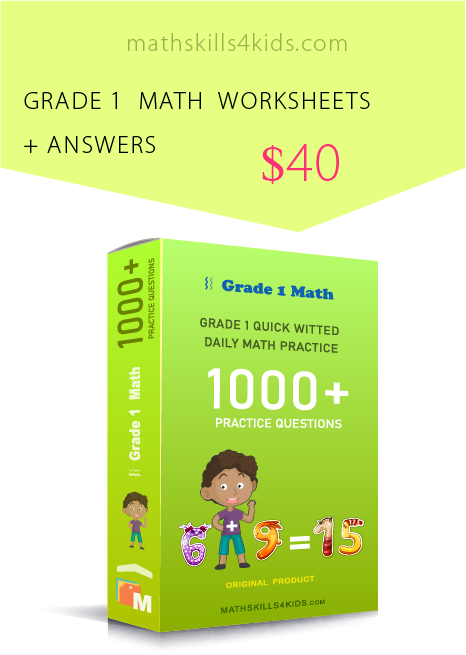
Buy Now...
-
-
What are 2d shapes, and how to identify them
A 2D shape is flat with only two dimensions: length and width. It does not have any thickness or depth. You can draw a 2D shape on paper or a screen.
To identify a 2D shape, you need to look at its features, such as:
- The number of sides it has. A side is a straight or curved line that forms the edge of a shape.
- The number of vertices it has. A vertex (plural: vertices) is a point where two or more sides meet. It is also called a corner.
- The type and size of angles it has. An angle is the amount of turn between two sides. There are three types of angles: acute (less than 90 degrees), right (exactly 90 degrees), and obtuse (more than 90 degrees).
- The length of its sides. Some shapes have equal sides (all the same length), while others have unequal sides (different lengths).
- The relationship between its sides. Some shapes have parallel sides (always the same distance apart), while others have perpendicular sides (meet at right angles). Some shapes have both parallel and perpendicular sides.
-
Types of 2D Shapes and their Properties
There are many types of 2D shapes, but here are some of the most common ones that you will encounter in our free printable 3rd Grade 2D shapes worksheets math practice:
- Circle: A circle is round with no sides or vertices. It has one curved line that is always the same distance from the center. The distance from the center to any point on the circle is called the radius. The distance across the circle through the center is called the diameter. The distance around the circle is called the circumference.
- Square: A square is a four-sided shape with four equal sides and four right angles. It has four vertices. A square is a special type of rectangle that has all equal sides.
- Rectangle: A rectangle is a four-sided shape with two pairs of equal sides and four right angles. It has four vertices. A rectangle can be a square if all its sides are equal.
- Triangle: A triangle is a three-sided shape with three vertices and angles. The sum of the angles in any triangle is always 180 degrees. There are different types of triangles based on their sides and angles:
- Equilateral triangle: A triangle with three equal sides and three equal angles (60 degrees each).
- Isosceles triangle: A triangle with two equal sides and two equal angles opposite them.
- Scalene triangle: A triangle that has no equal sides or angles.
- Right triangle: A triangle with one right angle and two acute angles.
- Acute triangle: A triangle that has three acute angles.
- Obtuse triangle: A triangle with one obtuse angle and two acute angles.
- Pentagon: A pentagon is a five-sided shape with five vertices and five angles. The sum of the angles in any pentagon is always 540 degrees. There are different types of pentagons based on their sides and angles:
- Regular pentagon: A pentagon has five equal sides and five equal angles (108 degrees each).
- Irregular pentagon: A pentagon that has no equal sides or angles.
- Hexagon: A hexagon is a six-sided shape with six vertices and six angles. The sum of the angles in any hexagon is always 720 degrees. There are different types of hexagons based on their sides and angles:
- Regular hexagon: A hexagon has six equal sides and six equal angles (120 degrees each).
- Irregular hexagon: A hexagon that has no equal sides or angles.
- Octagon: An octagon is an eight-sided shape with eight vertices and eight angles. The sum of the angles in any octagon is always 1080 degrees. There are different types of octagons based on their sides and angles:
- Regular octagon: An octagon with eight equal sides and eight equal angles (135 degrees each).
- Irregular octagon: An octagon that has no equal sides or angles.
-
How to compare and classify 2D shapes
To compare 2D shapes, look at their properties and their similarities or differences. For example, you can compare two shapes by their number of sides, vertices, type, size of angles, length of sides, relationship between sides, etc.
To classify 2D shapes, you need to group them into categories based on their properties. For example, you can classify shapes by their number of sides (quadrilaterals, pentagons, hexagons, etc.), by their type of angles (right, acute, obtuse, etc.), by their symmetry (symmetrical, asymmetrical), etc.
-
Fun activities to practice 2D shapes skills
Learning about 2D shapes can be fun and engaging with these activities:
- Shape Hunt: Go on a shape hunt around your house or neighborhood and find as many 2D shapes as possible. Take pictures or draw them in a notebook. Label each shape with its name and properties.
- Shape Art: Use different 2D shapes to create your artwork. You can cut out shapes from paper or cardboard or use stickers, stamps, or magnets. Arrange the shapes into patterns, designs, or pictures. You can also use shapes to make letters, numbers, or words.
- Shape Puzzles: Cut out different 2D shapes from paper or cardboard and mix them up. Then try to put them back together to form larger shapes. To make shape puzzles, you can also use tangrams, pattern blocks, or geoboards.
- Shape Bingo: Make your bingo cards with different 2D shapes on them. Then call out the names of the shapes and mark them on your card. The first one to get a row, column, or diagonal wins!
- Shape Memory: Make pairs of cards with matching 2D shapes. Shuffle the cards and place them face down on a table. Take turns flipping over two cards at a time and try to find the matching pairs. If you find a pair, keep it and go again. If not, turn them back over and let the next player try. The one with the most pairs at the end wins!
-
Our selection of Mathskills4kids’ free printable 3rd Grade 2D shapes worksheets for math practice
We have selected a variety of free printable 3rd-grade 2D shapes worksheets from Mathskills4kids.com that will help your 3rd graders practice their 2D shapes skills in a fun and engaging way. These worksheets cover different topics related to 2D shapes, such as:
- Identify two-dimensional shapes: In this worksheet, students will name the 2D shapes shown in the pictures. They can choose from a word bank that includes a circle, square, rectangle, triangle, pentagon, hexagon, octagon, trapezoid, parallelogram, and rhombus.
- Counting sides and vertices in 2-dimensional shapes: In this worksheet, students will count how many sides and vertices each 2D shape has and write the numbers in the boxes. They can use the shape names as a hint.
- Identify open and closed shapes: In this worksheet, students will identify which shapes are open and closed. They have to color the open shapes red and the closed shapes blue.
- Identifying a polygon: In this worksheet, students will identify which shapes are polygons and which are not. They have to color the polygons green and the non-polygons yellow.
- Identifying points, lines, line segments, and rays: In this worksheet, students will identify what kind of geometric element is shown in each picture. They have to write P for point, L for line, LS for line segment, or R for ray.
- Identifying angles greater than, less than, or equal to a right angle: In this worksheet, students will identify the angle type shown in each picture. They have to write > for greater than a right angle, < for less than a right angle, or = for equal to a right angle.
- Parallel, perpendicular, and intersecting lines: In this worksheet, students will identify the relationship between the pairs of lines shown in each picture. They will write P for parallel, PE for perpendicular, or I for intersecting.
- Reflection, rotation, and translation: In this worksheet, students will identify what transformation has been applied to each shape. They will write R for reflection, RO for rotation, or T for translation.
- How to identify congruent shapes: In this worksheet, students will identify which pairs of shapes are congruent and which are not. They have to color the congruent pairs green and the non-congruent pairs orange.
- Symmetry: In this worksheet, students will identify symmetrical shapes from asymmetrical ones. They have to draw a line of symmetry on each symmetrical shape and color it purple.
-
How to use 2D shapes worksheets effectively to boost 3rd graders’ math skills
These worksheets are designed to help third graders practice their 2D shapes skills in a fun and engaging way. However, they are not meant to replace direct instruction or hands-on activities. Here are some tips on how to use 2D shapes worksheets effectively to boost 3rd graders’ math skills:
- Before giving the worksheets to your students, review the concepts and vocabulary related to 2D shapes with them. You can use flashcards, posters, or interactive games to reinforce learning.
- Explain the instructions clearly and model how to complete each type of worksheet. You can use a projector or a smart board to show examples and demonstrate how to solve the problems.
- Provide feedback and guidance as your students work on the worksheets. You can check their answers with an answer key or use self-checking worksheets with QR codes or hidden messages.
- Encourage your students to use different strategies and tools to solve the problems. You can provide them with manipulatives such as geoboards or pattern blocks or let them use online tools such as virtual manipulatives or geometry apps.
- Differentiate the worksheets according to your student’s needs and abilities. You can modify the difficulty level, the number of problems, the type of questions, or the worksheet format to suit your student’s learning styles and preferences.
- Extend the learning beyond the worksheets by asking your students to apply their 2D shapes skills in real-life scenarios. You can ask them to find examples of 2D shapes in their environment, create them using different materials or design their worksheets for their peers.
-
Applying 2D shapes in real-life scenarios
One of the best ways to help your students understand and appreciate 2D shapes is to show them how they are used in real-life scenarios. Here are some examples of how you can connect 2D shapes to different subjects and topics:
- Art: You can ask your students to create artwork using different 2D shapes. You can inspire them with examples of famous artists who used geometric shapes in their paintings, such as Piet Mondrian, Wassily Kandinsky, or Paul Klee. You can also challenge them to create optical illusions or tessellations using 2D shapes.
- Science: You can ask your students to explore the properties and characteristics of 2D shapes with science concepts. For example, you can ask them to investigate how light reflects and refracts on different 2D shapes, how sound waves travel through different 2D shapes, or how forces affect the stability and strength of different 2D shapes.
- Social Studies: You can ask your students to identify and compare the 2D shapes used in different cultures and civilizations. For example, you can ask them to research how ancient Egyptians used 2D shapes in their architecture, art, and writing, how Native Americans used 2D shapes in their symbols and patterns, or how the Chinese used 2D shapes in their paper cutting and lantern making.
- Language Arts: You can ask your students to use 2D shapes as a creative writing prompt. For example, you can ask them to write a story based on a shape they draw or choose, a poem using shape words, or a riddle describing a shape without naming it.
Bonus: Find more resources to reinforce 2D shapes learning in Third Grade here!
If you are looking for more resources to reinforce 2D shapes learning in third grade, you are in luck! We have compiled a list of some of the best online resources that offer free games, videos, quizzes, and activities related to 2D shapes.
Here are some of our favorites:
- Math is Fun: This website has a lot of information and examples about 2D shapes, their properties, and how to classify them. You can also find interactive tools to explore shapes and measure angles. https://www.mathsisfun.com/geometry/plane-geometry.html
- Khan Academy: This online platform has a series of videos and exercises that cover 2D shapes and other geometry topics. You can watch the videos to learn new concepts, practice what you learned with quizzes, and track your progress. https://www.khanacademy.org/math/cc-third-grade-math/imp-geometry
- com: This website has a variety of games and worksheets that you can use to practice 2D shapes in a fun way. You can play matching games, puzzles, bingo, and more. You can also print out worksheets to color, cut, and glue shapes. https://www.education.com/resources/third-grade/geometry/
-
Thank you for sharing the links of MathSkills4Kids.com with your loved ones. Your choice is greatly appreciated.
Conclusion: Keep Practicing and Have Fun
We hope you enjoyed this article about free printable 3rd-grade 2D shapes worksheets for math practice. We hope these worksheets will help your students improve their 2D shapes skills and have fun along the way.
Remember to check out our other articles and website, Mathskills4kids.com, for more free printable worksheets for third graders on different math topics. Happy learning!
